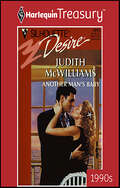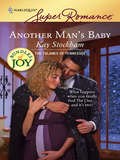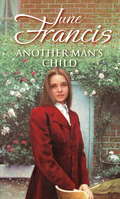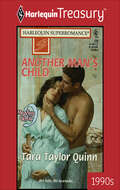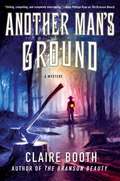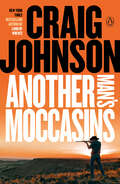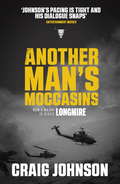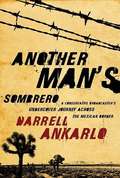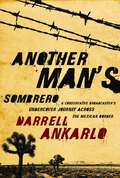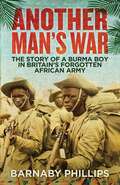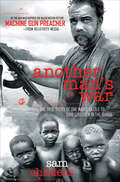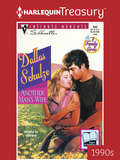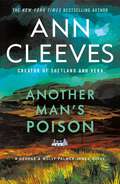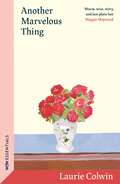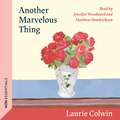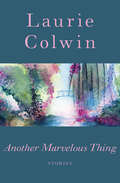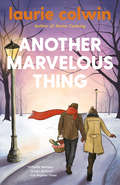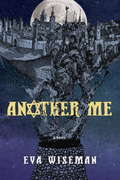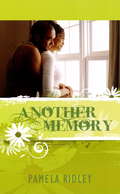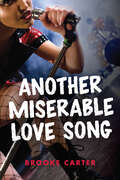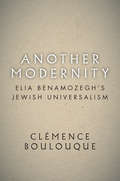- Table View
- List View
Another Man's Baby
by Judith McWilliamsHOW FAR WOULD SHE GO...?The mission: Ginny Alton had agreed to impersonate her cousin and travel halfway around the world with a newborn in order to have the child meet his paternal grandfather.The complication: Everyone believed she was the child's mother!The man: Philip Lysander knew Ginny was lying about something, so in order to protect his family, he told everyone he was the baby's father.Ginny suddenly found herself hopelessly attracted to the one man who could destroy her carefully constructed charade. But how could she deny herself the intensity of Philip's lovemaking when their time together was so short? Especially when he was about to discover the truth?
Another Man's Baby
by Kay StockhamGarret Tulane is Darcy Rhodes's personal knight in shining armor. Not only did he rescue her from being stranded in the middle of a snowstorm, but he's also given her a place to stay. His close family ties and his caring support create the secure home life she wants to give her unborn child. That security is an illusion, however. Despite the growing closeness between Darcy and Garret, she knows he has obligations and commitments that don't include her--or another man's baby. But feeling as she does, when the time comes, will she be able to walk away?
Another Man's Child
by June FrancisIt's 1909 and Molly May, her husband lost at sea and presumed dead, has escaped from her cruel in-laws in Liverpool along the Leeds-Liverpool canal to Burscough Bridge. Here she gives birth to a baby girl.Handsome widower Nathan Collins employs her as a wet-nurse to his daughter Jessica. But tragedy strikes when Jessica is found dead in her cot. Molly is terrified that she will be accused of murder, so when her own daughter is mistaken for Jessica, she is unable to tell the truth. Acting as a nanny to her own child isn't as hard as Molly imagined, especially as her relationship with Nathan deepens. But there is trouble ahead. Nathan's scheming mother Dorothy wastes no opportunity to remind Molly of her lowly position. And how can Molly win Nathan who, because of her lies, is raising another man's child as his own?
Another Man's Child (9 Months Later #8)
by Tara Taylor Quinn9 Months LaterHer baby. His heartache.Her baby. His heartache.Marcus Cartwright is rich and handsome. What's more, he's in love with his wife. And Lisa Cartwright adores her husband. Their marriage, however, is falling apart.That's because Marcus can't give Lisa the baby they've always longed for.Now he's determined to give Lisa her freedom-to find and marry someone else. To have her own child. It's a freedom Lisa doesn't want, but she can't convince Marcus of that.So Lisa decides to take matters into her own hands. She decides to have a baby. And she's not going to tell Marcus until the artificial insemination procedure is over....But will Marcus be able to accept another man's child?
Another Man's Ground: A Mystery
by Claire Booth"This contemporary take on a locked-room puzzle is chilling, compelling and completely entertaining, and Claire Booth is a wonderful new voice in crime fiction.”—Hank Phillippi Ryan on The Branson BeautyIt starts out as an interesting little theft case. Branson, Missouri’s new Sheriff Hank Worth is called out to look at stands of trees that have been stripped of their bark, which the property owner had planned to harvest for the booming herbal supplement market. At first, Hank easily balances the demands of the investigation with his fledging political career. He was appointed several months earlier to the vacant sheriff position, but he needs to win the fast-approaching election in order to keep his job. He thinks the campaign will go well, as long as he’s able to keep secret the fact that a group of undocumented immigrants – hired to cut down the stripped trees – have fled into the forest and he’s deliberately not looking for them.But then the discovery of a murder victim deep in the Ozark backwoods sets him in the middle of a generations-old feud that explodes into danger not only for him, but also for the immigrants, his deputies, and his family. He must rush to find a murderer before election day, and protect the vulnerable in Branson County, where politicking is hell and trespassing can get you killed.In Another Man's Ground, her next novel featuring Sheriff Hank Worth, acclaimed author Claire Booth delivers a taut, witty mystery that will grip readers from the opening pages to the breathless conclusion.
Another Man's Moccasins: A Longmire Mystery (A Longmire Mystery #No. 4)
by Craig JohnsonThe fourth book in the bestselling Longmire Mystery series, the basis for the hit Netflix Original series LONGMIRECraig Johnson's The Highwayman is now available from Viking. The latest in the Longmire series, An Obvious Fact, will be available in September 2016. Fans of Ace Atkins, Nevada Barr, and Robert B. Parker will love the fourth mystery in New York Times bestselling author Craig Johnson's award-winning Longmire Mystery series, the basis for LONGMIRE, the hit drama series now streaming on Netflix. It delivers more of the taut prose, engrossing characters, beautiful Wyoming setting, and satisfying depth that reviewers have been hailing since his first book, The Cold Dish. In Another Man's Moccasins, the body of a Vietnamese woman dumped along the Wyoming interstate opens a baffling case for Sheriff Longmire, whose only suspect is a Crow Indian with a troubled past. But things get even stranger when a photograph turns up in the victim's purse that ties her murder to one from Longmire's past--a case he tackled as a Marine Corps investigator forty years earlier in Vietnam.From the Trade Paperback edition.
Another Man's Moccasins: A breath-taking instalment of the best-selling, award-winning series - now a hit Netflix show! (A Walt Longmire Mystery #4)
by Craig JohnsonThe fourth book in the New York Times bestselling Longmire series, featuring Sheriff Walt Longmire.When the body of a young Vietnamese woman is found alongside the interstate in Absaroka County, Sheriff Walt Longmire is determined to discover the identity of the victim and is forced to confront the horrible similarities of this murder to that of his first homicide case as a Marine investigator in Vietnam. To complicate matters, Virgil White Buffalo, a Crow Indian, is found living in a nearby culvert and in possession of the young woman's purse.There are only two problems with what appears to be an open-and-shut case. One, the sheriff doesn't think Virgil White Buffalo - a Vietnam vet with a troubling past - is a murderer. And two, the photo that is found in the woman's purse looks hauntingly familiar to Walt.'A rising star' Los Angeles Times
Another Man's Ring
by Angela CarsonJudi knew she didn't want to marry Robert-but two sets of parents and the prospective bridegroom were firmly lined up against her. When she was offered a job in Thailand, Judi seized the chance to escape. Her job as secretary to the irascible Nick Compton was rather more of a challenge than she'd expected. She wondered if she'd jumped from the frying pan into the fire. The work she could cope with-but she suspected Nick was too hot to handle!
Another Man's Sombrero: A Conservative Broadcaster's Undercover Journey Across the Mexican Border
by Darrell AnkarloAnother Man's Sombrero explores issues raised by the personal stories of Mexican citizens sneaking into America and offers perspectives--often contradictory--from U.S. citizens.
Another Man's Sombrero: A Conservative Broadcaster's Undercover Journey Across the Mexican Border
by Darrell AnkarloNot since the Civil War has America been so divided over such a seemingly unsolvable issue as U.S. immigration policy.The president and congress are at an impasse, while vigilante groups patrol our nation's borders looking for one of the million yearly invaders. Why are 20 million people disregarding America's sovereign borders and laws to come to this country? Popular radio host Darrell Ankarlo follows the lives of several Mexican citizens as they contemplate their existence south of the border, their temptation to sneak into America, and what waits for them here. To understand the issue first-hand, Ankarlo stared down gun barrels, was caught in the middle of a drug-lord showdown, and then wandered the Arizona desert after illegally sneaking back into America. Another Man's Sombrero explores issues raised by these personal stories and offers perspectives-often contradictory-from U.S. citizens.
Another Man's War: The Story Of A Burma Boy In Britain's Forgotten Army
by Barnaby PhillipsIn December 1941 the Japanese invaded Burma. For the British, the longest land campaign of the Second World War had begun. 100,000 African soldiers were taken from Britain’s colonies to fight the Japanese in the Burmese jungles. They performed heroically in one of the most brutal theatres of war, yet their contribution has been largely ignored. Isaac Fadoyebo was one of those 'Burma Boys’. At the age of sixteen he ran away from his Nigerian village to join the British Army. Sent to Burma, he was attacked and left for dead in the jungle by the Japanese. Sheltered by courageous local rice farmers, Isaac spent nine months in hiding before his eventual rescue. He returned to Nigeria a hero, but his story was soon forgotten. Barnaby Phillips travelled to Nigeria and Burma in search of Isaac, the family who saved his life, and the legacy of an Empire. Another Man’s War is Isaac’s story.
Another Man's War: The True Story of One Man's Battle to Save Children in the Sudan
by Sam ChildersA gun-toting preacher, a rebel army led by a madman, and entire villages slaughtered just because they were in the way.In Another Man's War, follow Sam Childer's remarkable transformation from violent thug to a man of faith, and his ongoing battle to save children in one of the world's most lawless areas.“Another Man’s War is about true terrorism . . . against more than 200,000 children in northern Uganda and Southern Sudan. Sam Childers—a fighter and a preacher (some call him a mercenary)—tirelessly leads a small militia into the jungle, daring to fight against a vicious army outnumbering him one thousand to one. One man can make a huge difference. Sam Childers certainly does.” ?Peter Fonda, actor/filmmaker, best known as star of Easy Rider“The Reverend Sam Childers has been a very close friend to the government of South Sudan for many years and is a trusted friend.” ?President Salva Kiir Mayardit of South Sudan“The Reverend Sam Childers is a long time devoted friend to our government and his courageous work is supported by us.” ?President Yoweri Museveni of Uganda“Sam Childers is one of those rare men [who is] willing to do literally whatever it takes to promote the message of Jesus Christ and save children from the tyranny of evil men.” ?John Rich, lead singer and songwriter, Big & Rich
Another Man's Wife
by Dallas SchulzePicking Up the Pieces...When a car accident left Gage Walker's best friend's wife a widow and a single mom, Gage knew he had to step in and help out the family. While Gage didn't believe in roots and attachments, he did believe in responsibility. Trouble was, his "friendship" with Kelsey was stirring up all kinds of feelings that he had buried long ago, like passion, commitment-and pure, raw need. And those feelings could only lead to one thing...
Another Man’s Poison: A George & Molly Palmer-Jones Novel (George & Molly Palmer-Jones Series)
by Ann CleevesBefore Shetland and Vera, Ann Cleeves wrote the George and Molly Palmer-Jones series following remarkable mysteries in a birdwatching community—now in print for the first time in the US.Landlord and politician Marcus Grenville wants to convert Ursula Ottway’s beautiful cottage into a holiday residence. So when Ursula discovers that the illegal use of poisoned bait on Grenville’s land has killed not only a rare bird of prey but her two beloved cats, she storms to his house and threatens revenge.The next morning, Molly Palmer-Jones arrives at her Aunt Ursula’s house only to find her body slumped lifeless on the sofa. Shocked and saddened, Molly and her husband George decide to piece together a picture of Ursula’s last days. And it soon becomes clear that, for many people on the estate, hers was a very convenient death.The Palmer-Joneses embark on a murder investigation but even their professional expertise doesn’t prepare them for what is to follow. A lifetime’s worth of secrets must surface before a killer can finally be brought to justice . . .
Another Marvelous Thing (W&N Essentials)
by Laurie Colwin'Warm, wise, witty, and just plain fun' Maggie Shipstead At a perfectly ordinary cocktail party, Francis is introduced to Billy and - although it slips right by him at the time - he falls in love with her at once.Billy is a serious, often glum person. An economic historian, she is indifferent to a great many things (clothes, food, home décor), frowns easily and is frequently irritated. Francis is older. He likes routine and a well-run household; he likes to pay for dinner, open car doors and call Billy at night to make sure she is safe. Both are happily married - but not to each other. So begins a whirlwind love affair, perfectly captured in this frank, funny irresistible novel, from its fabulous inception to its inevitable end. A W&N Essential with an introduction by Caroline O'Donoghue
Another Marvelous Thing (W&N Essentials)
by Laurie Colwin'Warm, wise, witty, and just plain fun' Maggie Shipstead At a perfectly ordinary cocktail party, Francis is introduced to Billy and - although it slips right by him at the time - he falls in love with her at once.Billy is a serious, often glum person. An economic historian, she is indifferent to a great many things (clothes, food, home décor), frowns easily and is frequently irritated. Francis is older. He likes routine and a well-run household; he likes to pay for dinner, open car doors and call Billy at night to make sure she is safe. Both are happily married - but not to each other. So begins a whirlwind love affair, perfectly captured in this frank, funny irresistible novel, from its fabulous inception to its inevitable end. A W&N Essential with an introduction by Caroline O'Donoghue
Another Marvelous Thing: Stories
by Laurie ColwinThe poignant and perceptive tale of an affair, from intoxicating first kiss to bittersweet good-bye Josephine "Billy" Delielle and Francis Clemens are sleeping together. Both are economists and both are married to other people, but the similarities end there. He is fastidious; she is a slob. He delights in good food and fine wine; her refrigerator is always empty. He is old and sentimental; she is young and tough minded. This is not his first extramarital dalliance; she never imagined it was possible to love anyone but her husband. The desire that Billy and Francis feel for each other is as inexplicable as it is undeniable, and the moments they steal together are electrifying, tense, and reassuring all at once. Told from the alternating perspectives of two adulterous lovers, Another Marvelous Thing is an exquisitely crafted story collection that tackles the thorniest of subjects with honesty, grace, and humor. This ebook features an illustrated biography of Laurie Colwin including rare photos and never-before-seen documents from the author's estate.
Another Marvelous Thing: Stories
by Laurie ColwinBilly Delielle and Francis Clemens are happily married--just not to each other. Another Marvelous Thing is the story of their affair from its fabulous inception to its inevitable end. Billy and Francis couldn't be more different in age, background and disposition, and their whirlwind romance, perfectly captured in Cowin-esque frank and funny style, is firm proof that opposites really do attract. In interconnected stories, Colwin deftly reveals each character's point of view and examines, in razor-ship detail, the "marvelous" and messy glory of modern romance and the curious desires of the heart.
Another Me
by Eva WisemanSet against the backdrop of plague-ravaged Europe, this spellbinding new novel from one of Canada's foremost writers of historical fiction for young people will have readers racing to the electrifying climax. Seventeen-year-old Natan has a safe and happy life in fourteenth-century Strasbourg, France. He works with his father in his rag trade, helps his mother around the house, and studies the Torah at night with his young brother, Shmuli. He's even feeling the first stirrings of love with Elena, the daughter of the master draper who is his father's best customer. But something is rotten in the streets of Strasbourg. There is tension between the Jewish community and the rest of the citizens, and there is fear as the deadly plague sweeps through towns and cities nearby. When rumors begin to circulate that Jewish residents are contaminating the town's well water to try to hasten the plague's arrival in their city, Natan knows that there are dangerous days ahead. When he sees who really poisoned Strasbourg's water, he is determined to speak the truth and save his people from the false accusations being made against them. But a moment of violence threatens to derail his plans and change his life in ways he could never have imagined.
Another Memory
by Pamela RidleyTen years after the death of her baby, husband, and mother-in-law in an airplane crash, forty-two-year-old Chelly Whitaker understands nothing is permanent. Disconnected from life with only the ghostly visits of her daughter, Maya, to hold on to, she fills her days with activities. But when it comes to romance, Chelly is convinced she has no love left to give.Sean Price, thirty-three, having faced the death of his mother and the impending death of his previously absent father, realizes the brevity and fragility of life. This compels him to cling to the roots he does have and strive to build a future that embraces love. Sean's father, Kelvin Price, relies on insight, wit and help from Maya to guide Sean in shaping a positive future as Sean and Chelly let go of devastating memories, face a threat to their lives, and learn to love again.
Another Mind-Body Problem: A History of Racial Non-being (SUNY series, Philosophy and Race)
by John HarfouchThe mind-body problem in philosophy is typically understood as a discourse concerning the relation of mental states to physical states, and the experience of sensation. On this level it seems to transcend issues of race and racism, but Another Mind-Body Problem demonstrates that racial distinctions have been an integral part of the discourse since the Modern period in philosophy. Reading figures such as Descartes, Leibniz, and Kant in their historical contexts, John Harfouch uncovers discussions of mind and body that engaged closely with philosophical and scientific notions of race in metaphysics and the philosophy of mind, in particular in understanding how the mind unites with the body at birth and is then passed on through sexual reproduction. Kant argued that a person's exterior body and interior psyche are bound together, that non-White people lacked reason, and that this lack of reason was carried on through reproduction such that non-Whites were an example of a union of mind and body without full being. Charting the development of this phenomenon from sixteenth-century medical literature to modern-day race discourse, Harfouch argues for new understandings of Descartes's mind-body problem, Fanon's experience of being 'not-yet human,' and the place of racism in relation to one of philosophy's most enduring and canonical problems.
Another Miserable Love Song (Orca Soundings)
by Brooke CarterKey Selling Points Main character's love interest is trans, disclosed partway through story but incidental to narrative. Enhanced features (dyslexia-friendly font, cream paper, larger trim size) to increase reading accessibility for dyslexic and other striving readers.
Another Modernity: Elia Benamozegh’s Jewish Universalism (Stanford Studies in Jewish History and Culture)
by Clémence BoulouqueAnother Modernity is a rich study of the life and thought of Elia Benamozegh, a nineteenth-century rabbi and philosopher whose work profoundly influenced Christian-Jewish dialogue in twentieth-century Europe. Benamozegh, a Livornese rabbi of Moroccan descent, was a prolific writer and transnational thinker who corresponded widely with religious and intellectual figures in France, the Maghreb, and the Middle East. This idiosyncratic figure, who argued for the universalism of Judaism and for interreligious engagement, came to influence a spectrum of religious thinkers so varied that it includes proponents of the ecumenical Second Vatican Council, American evangelists, and right-wing Zionists in Israel. What Benamozegh proposed was unprecedented: that the Jewish tradition presented a solution to the religious crisis of modernity. According to Benamozegh, the defining features of Judaism were universalism, a capacity to foster interreligious engagement, and the political power and mythical allure of its theosophical tradition, Kabbalah—all of which made the Jewish tradition uniquely equipped to assuage the post-Enlightenment tensions between religion and reason. In this book, Clémence Boulouque presents a wide-ranging and nuanced investigation of Benamozegh's published and unpublished work and his continuing legacy, considering his impact on Christian-Jewish dialogue as well as on far-right Christians and right-wing religious Zionists.
